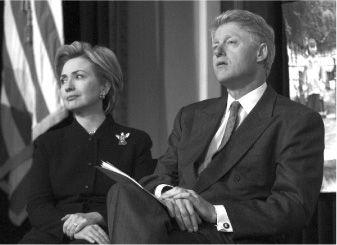The Definitive Book of Body Language (41 page)
Read The Definitive Book of Body Language Online
Authors: Barbara Pease,Allan Pease

The Beckhams don't look at all alike until they smile

Forty years of mirroring—the Beckhams at retirement with their dog Spot
In 2000, psychologist Dr. John Gottman of the University of Washington, Seattle, and his colleagues discovered that marriages are more likely to fail when one partner not only does not mirror the other's expressions of happiness, but instead shows expressions of contempt. Instead, this opposite behavior affects the smiling partner, even when they are not consciously aware of what is happening.
You can also see mirroring occur in the pets some people choose. Without realizing it, we unconsciously tend to favor
pets that physically resemble us, or that appear to reflect our attitudes.
To demonstrate the point, here are a few examples:
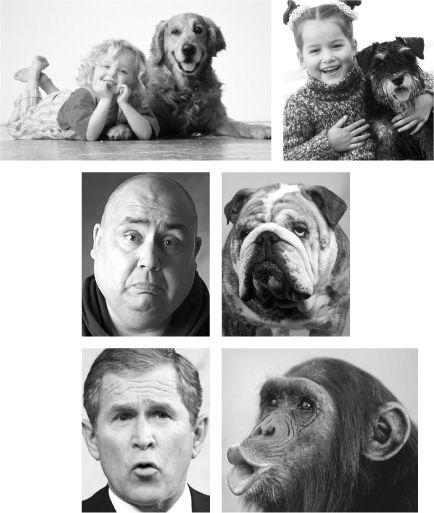
Do we choose pets that resemble us?
The next time you attend a social function or go to a place where people meet and interact, notice the number of people who have taken the identical gestures and posture of the person with
whom they're talking. Mirroring is the way one person tells another that he is in agreement with his ideas and attitudes. One is nonverbally saying to the other, “As you can see, I think the same as you.” The person with the highest status often makes the first moves and the others copy, usually in pecking order.
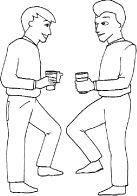
Thinking alike
Take, for example, the two men standing at the bar in the above illustration. They are mirroring, so it's reasonable to assume that they are discussing a topic on which they have similar thoughts and feelings. If one man uses an evaluation gesture or stands on the other foot, the other will copy. One puts a hand in his pocket, the other copies again. Mirroring will continue for as long as the two are in agreement.
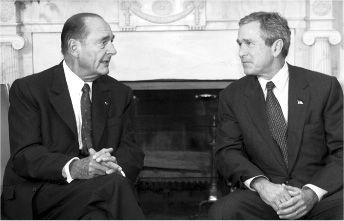
Even when Presidents Bush and Chirac disagree verbally, they still
usually mirror each other—this shows they have mutual respect
Mirroring happens among friends or between people of the same status and it is common to see married couples walk, stand, sit, and move in identical ways. Albert Scheflen found that people who are strangers studiously
avoid
holding mirror positions.
Intonation, voice inflection, speed of speaking, and even accents also synchronize during the mirroring process to further establish mutual attitudes and build rapport. This is known as “pacing” and it can almost seem as if the two people are singing in tune. You will often see a speaker beating time with his hands while the listener matches the rhythm with head nods. As a relationship grows over time, the mirroring of the main body-language positions becomes less as each person begins to anticipate the other's attitudes, and vocal pacing with the other person becomes a main medium for maintaining rapport.
Never speak at a faster rate than the other person. Studies reveal that others describe feeling “pressured” when someone speaks more quickly than they do. A person's speed of speech shows the rate at which their brain can consciously analyze information. Speak at the same rate or slightly slower than the other person and mirror their inflection and intonation. Pacing is critical when attempting to make appointments by telephone because voice is your only communication medium.
The significance of mirroring is one of the most important body-language lessons you can learn because it's a clear way in which others tell us that they agree with us or like us. It is also a way for us to tell others that we like them, by simply mirroring their body language.
If a boss wants to develop a rapport and create a relaxed atmosphere with a nervous employee, he could copy the employee's posture to achieve this end. Similarly, an up-and-coming employee may be seen copying his boss's gestures in an attempt to show agreement when the boss is giving his opinion. Using this knowledge, it is possible to influence others by mirroring their positive gestures and posture. This has the effect of putting the other person in a receptive and relaxed frame of mind, because he can “see” that you understand his point of view.

Mirroring the other person's body language to gain acceptance
Before you mirror someone's body language, however, you must take into consideration your relationship with that person. Let's say, for example, the junior employee of a corporation has asked for a pay raise and is called into the manager's office. The employee enters the manager's office, the manager asks him to sit down and assumes the Catapult with a Figure Four showing the employee a superior, dominant attitude. But what would happen if the junior then copied the manager's dominant body language while discussing the potential salary raise?
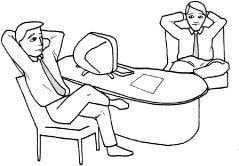
A boss would perceive a subordinate's mirroring behavior as arrogance
Even if the employee's talk was on a subordinate level, the manager could feel affronted by the employee's body language and his job could be in jeopardy Mirroring is also effective for intimidating or disarming “superior” types who try to take control. Accountants, lawyers, and managers are notorious for using superiority body-language clusters around people they consider inferior. By mirroring, you can disconcert them and force a change of position. But never do it to the boss.

They have the same posture and body language and
the close distance between them shows they are friends
going about business in the same way with similar goals
Research shows that when the leader of a group assumes certain gestures and positions, subordinates will copy, usually in pecking order. Leaders also tend to be the first of a group to walk through a doorway and they like to sit on the end of a sofa, table, or bench seat rather than in the center. When a group of executives walks into a room, the person with the highest status usually goes first. When executives are seated in the boardroom,
the boss usually sits at the head of the table, often farthest from the door. If the boss sits in the Catapult, his subordinates are likely to copy in order of their importance within the group. You can see this in a meeting where people “take sides” with others by mirroring their body language. This lets you see who will vote with you and who will vote against you.
Mirroring is a good strategy to use if you are part of a presentation team. Decide, in advance, that when the team spokesperson makes a gesture or takes a posture when speaking, the entire team will mirror. This not only gives your team the powerful appearance of being cohesive, it can frighten the hell out of competitors who suspect something is up, even though they can't quite figure out what it is.
